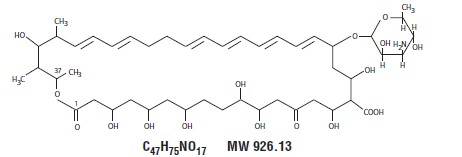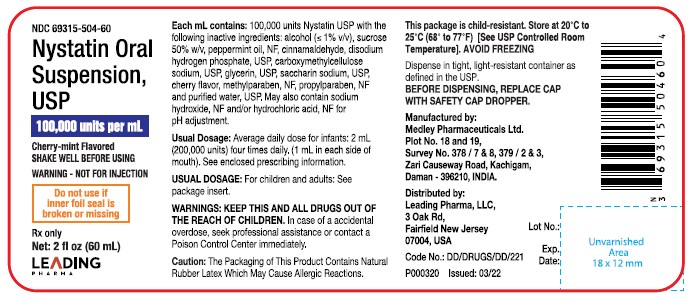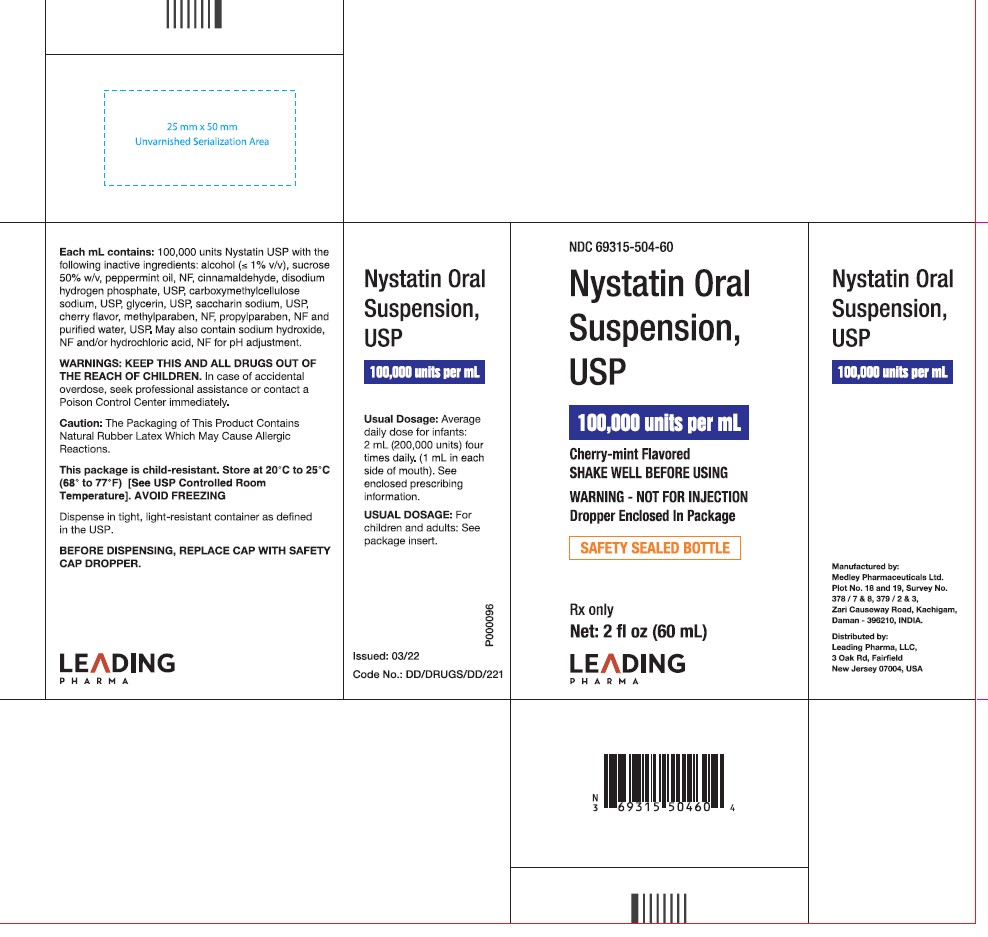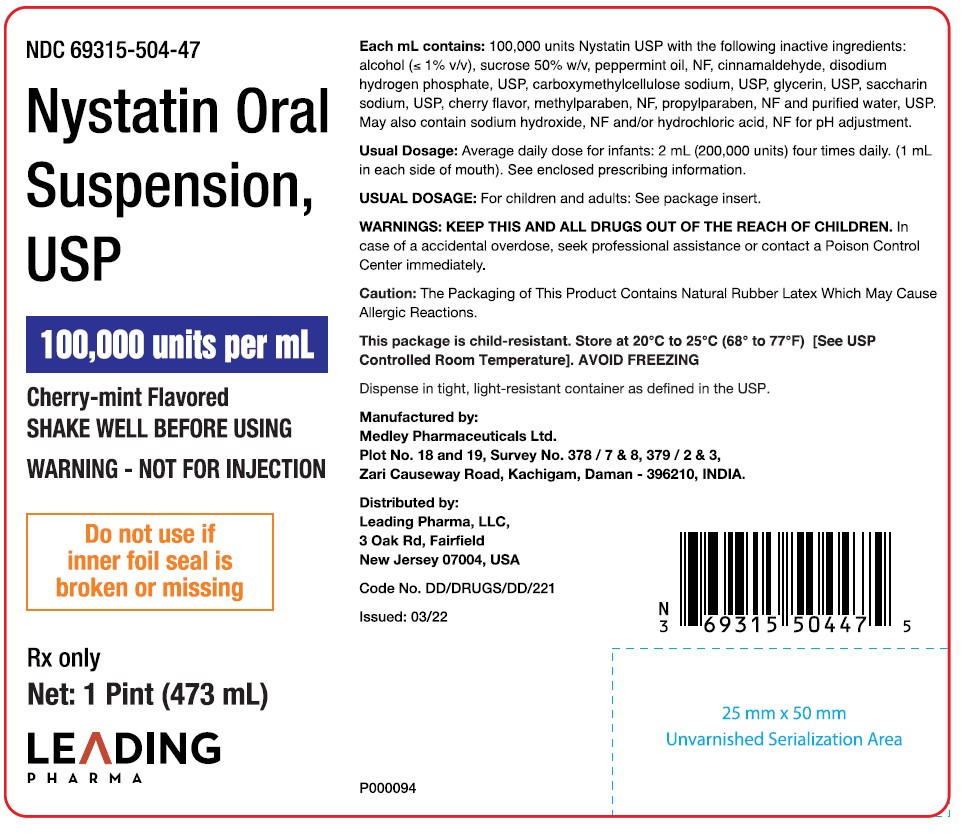NYSTATIN by Leading Pharma, LLC / Medley Pharmaceuticals Limited NYSTATIN suspension
NYSTATIN by
Drug Labeling and Warnings
NYSTATIN by is a Prescription medication manufactured, distributed, or labeled by Leading Pharma, LLC, Medley Pharmaceuticals Limited. Drug facts, warnings, and ingredients follow.
Drug Details [pdf]
-
DESCRIPTION
Nystatin is obtained from Streptomyces noursei. It is known to be a mixture, but the composition has not been completely elucidated. Nystatin A is closely related to amphotericin B. Each is a macro-cyclic lactone containing a ketal ring, an all-trans polyene system, and a mycosamine (3-amino-3-deoxyrhamose) moiety.
Structural formula:
Nystatin Oral Suspension, for oral administration, contains 100,000 USP Nystatin Units per mL. Inactive ingredients: alcohol (≤ 1% v/v), sucrose 50% w/v, peppermint oil, NF, cinnamaldehyde, disodium hydrogen phosphate, USP, carboxymethylcellulose sodium, USP, glycerin, USP, saccharin sodium, USP, cherry flavor, methylparaben, NF, propylparaben, NF and purified water, USP. May also contain sodium hydroxide, NF and/ or hydrochloric acid, NF for pH adjustment.
-
CLINICAL PHARMACOLOGY
Nystatin acts by binding to sterols in the cell membrane of the fungus with a resultant change in membrane permeability allowing leakage of intracellular components. Nystatin is absorbed very sparingly following oral administration, with no detectable blood levels when given in the recommended doses.
- INDICATIONS AND USAGE
- CONTRAINDICATIONS
-
PRECAUTIONS
General
Discontinue treatment with nystatin if sensitization or irritation is reported during use.
Nystatin is not effective in the treatment of systemic mycoses since it is not significantly absorbed from the gastrointestinal
tract.Information for the Patient
Patient should be advised to retain nystatin in the mouth as long as possible and to continue its use for at least 2 days after symptoms have subsided.There should be no interruption or discontinuation of the medication until the prescribed course of treatment is completed, even though symptomatic relief may occur within a few days.
If symptoms of local irritation develop, the physician should be notified immediately.Laboratory Tests
If there is a lack of therapeutic response, appropriate microbiological studies (e .g., KOH smears and/or cultures) should be repeated to confirm the diagnosis of candidiasis and rule out other pathogens before instituting another course of therapy.Carcinogenesis, Mutagenesis, Impairment of Fertility
No long-term animal studies have been performed to evaluate the carcinogenic potential of nystatin. In mice exposed to nystatin 50 mg/kg by injection, an increased incidence of chromosomal aberrations, consisting primarily of chromatid breaks, was observed in bone marrow cells. However, there have been no studies to determine the mutagenicity of orally-administered nystatin or its effects on fertility in males or females.Pregnancy:
Teratogenic Effects
Teratogenicity studies have not been conducted with nystatin. It is also not known whether nystatin can cause fetal harm when administered to a pregnant woman or can affect reproduction capacity. Nystatin should be given to a pregnant woman only if clearly needed.Nonteratogenic Effects
In one rat reproductive study, nystatin was administered orally to pregnant rats in single doses of 100, 500, or 3000 mg/kg on the ninth day of gestation, or as multiple doses of 500 mg/kg/day on gestation days 1-20, 1-4, 7-10, 11-14, or 15-18. It was found that nystatin had a slight abortive effect when used during the whole period of pregnancy. No abnormalities were seen in surviving fetuses. Although no adverse effects or complications have been attributed to the use of intra-vaginal nystatin in neonates born to women treated during pregnancy, no similar studies evaluating complications of oral nystatin have been conducted.Nursing Mothers
It is not known whether nystatin is excreted in human milk. Because many drugs are excreted in human milk, caution should be exercised when nystatin is administered to a nursing woman.Pediatric Use
See DOSAGE AND ADMINISTRATION section for pediatric dosing recommendations. -
ADVERSE REACTIONS
To report SUSPECTED ADVERSE REACTIONS, contact FDA at 1-800-FDA-1088 OR LEADING PHARMA, LLC AT 1-844-740-7500 or www.fda.gov/medwatch.
Gastrointestinal symptoms including diarrhea, gastrointestinal distress, nausea, vomiting and burning of the mouth have been reported. Hypersensitivity reactions including rash, pruritus, and anaphylactoid reaction have also been reported.
- OVERDOSAGE
-
DOSAGE AND ADMINISTRATION
Infants: 2 mL (200,000 units) four times daily (1 mL in each side of mouth).
Pediatric patients and adults: 4 to 6 mL (400,000 to 600,000 units) four times daily (one-half of dose in each side of mouth).
NOTE: Limited clinical studies in neonates, including premature and low-birth weight neonates, indicate that 1 mL (100,000 units) four times daily is effective.
Local treatment should be continued at least 48 hours after perioral symptoms have disappeared and/or cultures returned to normal. It is recommended that the drug be retained in the mouth as long as possible before swallowing.
- CAUTION
-
HOW SUPPLIED
Nystatin Oral Suspension, USP, 100,000 USP Nystatin Units per mL, is available as a cherry-mint flavored, light creamy yellow, ready-to-use suspension, in the following sizes: 60 mL bottles with a child-resistant cap and calibrated dropper.
1 Pint (473 mL) bottles with a child-resistant cap.Storage
This package is child-resistant. Keep out of reach of children. Store at 20° to 25°C (68° to 77°F) [see USP Controlled Room Temperature]. Avoid freezingNDC for 60 ml: 69315-504-60
NDC for 473 ml: 69315-504-47Rx Only
- SPL UNCLASSIFIED SECTION
- PRINCIPAL DISPLAY PANEL
-
INGREDIENTS AND APPEARANCE
NYSTATIN
nystatin suspensionProduct Information Product Type HUMAN PRESCRIPTION DRUG Item Code (Source) NDC: 69315-504 Route of Administration ORAL Active Ingredient/Active Moiety Ingredient Name Basis of Strength Strength NYSTATIN (UNII: BDF1O1C72E) (NYSTATIN - UNII:BDF1O1C72E) NYSTATIN 100000 [USP'U] in 1 mL Inactive Ingredients Ingredient Name Strength ALCOHOL (UNII: 3K9958V90M) SUCROSE (UNII: C151H8M554) PEPPERMINT OIL (UNII: AV092KU4JH) CINNAMALDEHYDE (UNII: SR60A3XG0F) SODIUM PHOSPHATE, DIBASIC, ANHYDROUS (UNII: 22ADO53M6F) CARBOXYMETHYLCELLULOSE SODIUM (UNII: K679OBS311) GLYCERIN (UNII: PDC6A3C0OX) SACCHARIN SODIUM (UNII: SB8ZUX40TY) METHYLPARABEN (UNII: A2I8C7HI9T) PROPYLPARABEN (UNII: Z8IX2SC1OH) WATER (UNII: 059QF0KO0R) SODIUM HYDROXIDE (UNII: 55X04QC32I) HYDROCHLORIC ACID (UNII: QTT17582CB) Product Characteristics Color yellow (light creamy yellow) Score Shape Size Flavor CHERRY (cherry-mint flavored) Imprint Code Contains Packaging # Item Code Package Description Marketing Start Date Marketing End Date 1 NDC: 69315-504-60 1 in 1 PACKAGE 12/05/2022 1 60 mL in 1 BOTTLE; Type 0: Not a Combination Product 2 NDC: 69315-504-47 473 mL in 1 BOTTLE; Type 0: Not a Combination Product 12/05/2022 Marketing Information Marketing Category Application Number or Monograph Citation Marketing Start Date Marketing End Date ANDA ANDA214346 12/05/2022 Labeler - Leading Pharma, LLC (079575060) Registrant - Medley Pharmaceuticals Limited (677602480) Establishment Name Address ID/FEI Business Operations Medley Pharmaceuticals Limited 677602480 manufacture(69315-504)
© 2025 FDA.report
This site is not affiliated with or endorsed by the FDA.


